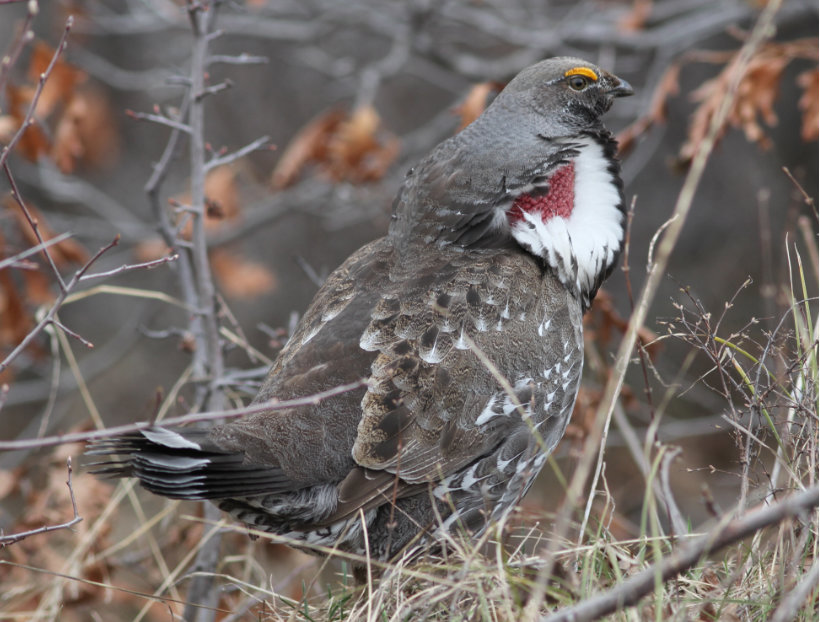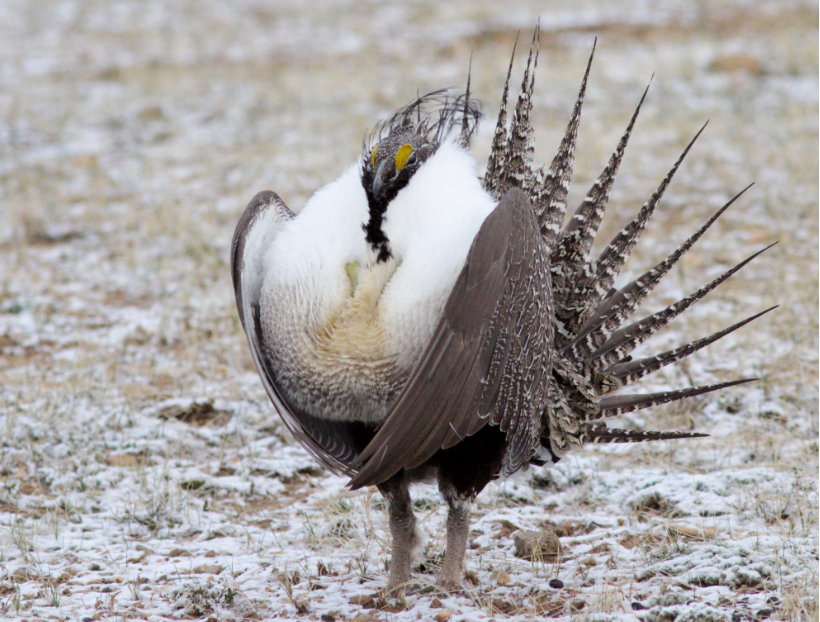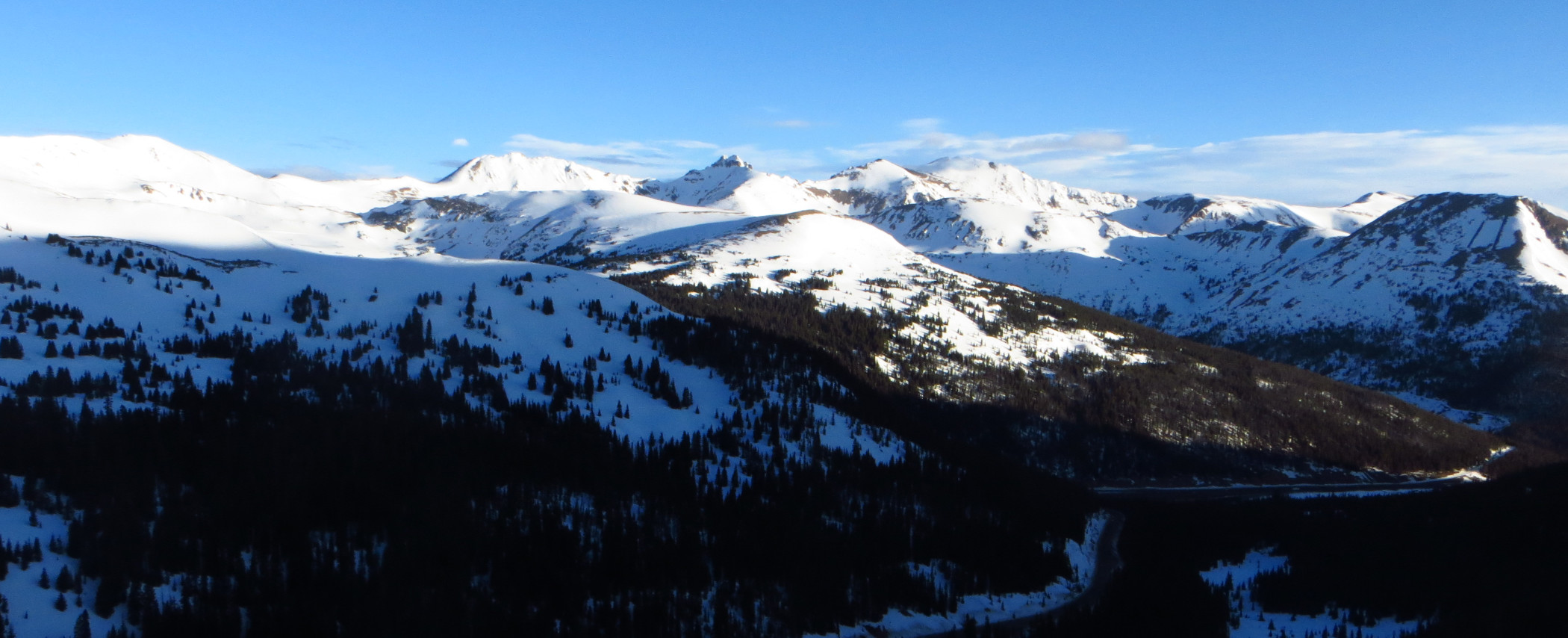
Text and photos by Stephan Lorenz
Truth be told, we are not chasing any chickens in the sense of Gallus gallus domesticus as there are in fact no Gallus or wild junglefowl in Colorado. If anyone fancies the antics of feral Red Junglefowl in North America, one must travel to warmer climes, either Key West in Florida or Kauai in the Hawaiian Islands where the roosters regularly raid the plates of unsuspecting picnickers. Trust me, I’ve seen it.
In Colorado, we are on a quest for something much better than feathered drumsticks. Our adventure loops in a figure eight around the entire state of Colorado, including a slice of Kansas, and tracks down a full plate of native grouse species with a side order of New World quail for a birding and photographic feast. So, if you would like to know what “chickens” we do chase, continue reading…
During the beginning of April, the grouse acquire their breeding finery and flaunt all caution in order to perform ancient displays that include foot-stomping dances of prairie chickens, air sac popping of Sage Grouse, tail raises of Sharp-tailed Grouse, and the booming of Dusky Grouse. In all, we will look for ten species of native grouse and quail with Wild Turkey plus the introduced Ring-necked Pheasant and Chukar treated as honorific “chickens”, for a total of thirteen gallinaceous bird species.
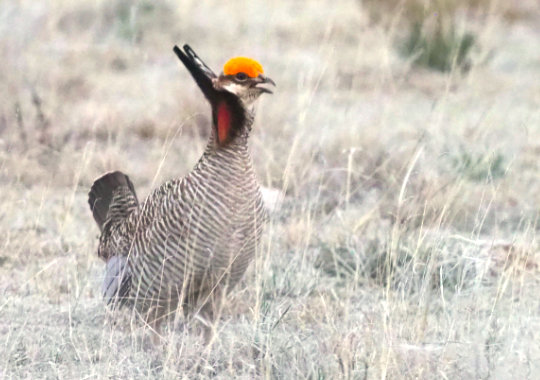
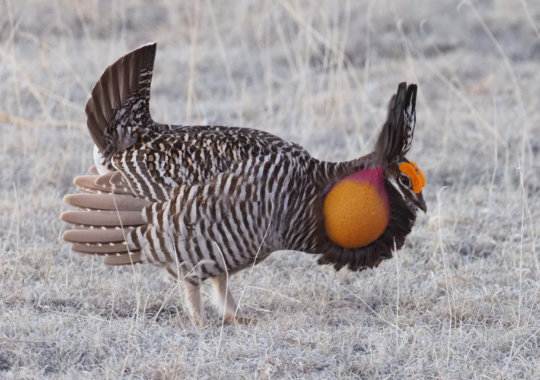
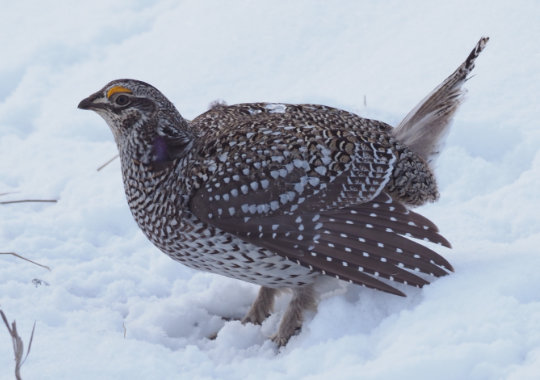
While such a fast-paced tour with many new sights and sounds may threaten to morph into a 4000-kilometre blur of ruffled feathers, cold feet, and many litres of coffee, it never does. Each morning’s outing and lek edges itself sharply into one’s memory and fills up plenty of SD cards too. The distances covered during this tour may seem vast at first glance, but the smooth road system makes transfers comfortable, allowing for welcome naps in order to be reenergized for the next early morning or relaxed contemplation of the ever changing and breathtaking landscapes of Colorado. The long drives are punctuated by many birding stops that add a full array of Rock Mountain specialties, ranging from rosy-finches to a wide variety of woodpeckers and jays.
Hands down, Colorado is the best place to observe the largest variety of “chickens” in the United States with a phenomenal backdrop of endless shortgrass prairie and the rugged Rocky Mountains. So, let me take you through the wonderful ten mornings we spend in what is arguably one of the most beautiful corners of the United States.
Our first early morning starts in the foothills of the Rocky Mountains just outside of Pueblo where the air is clear and crisp. An unlikely place to begin a journey for the native grouse and quail as we bird along the edge of a small neighborhood where scattered houses sit within sight of the Rocky Mountains that rise majestically from the plains. Yet, this stop will garner us the first quail of the trip, the subtly marked Scaled Quail. This species prefers the arid foothills and deserts of the southern United States, reaching its northern limit in southern Colorado. The birds prefer the landscaped gardens and occasional bird feeders, allowing us great views once we locate them. Scaled Quails call regularly during the early morning, making it easier to track them. With a male teed up on a fence post, we can study the soft hues of browns and greys forming a sharp scaly pattern on its underparts that is unmistakable, all accentuated by a crest atop a small head. In this habitat, we can also find species more typical of arid areas to the south, including Canyon Towhee, Curve-billed Thrasher, and Chihuahuan Raven.
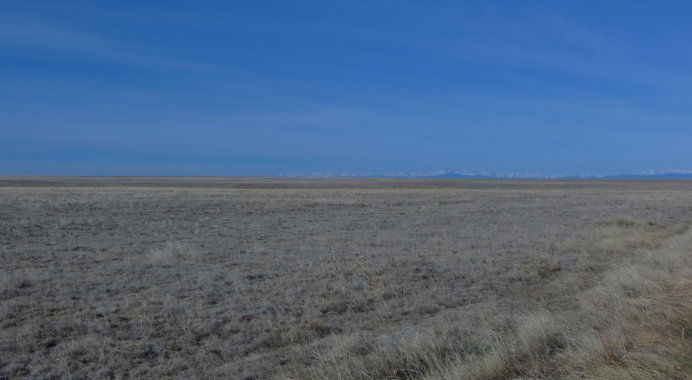
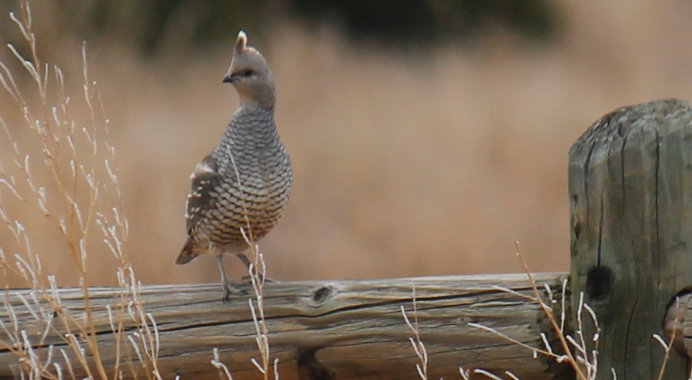
The morning on the Kansas prairies starts well before sunrise as we travel to a remote patch of grassland before the prairie chickens start calling. This is the first true lek that we visit. The word lek is derived from the Swedish word lekställe which roughly translates as mating ground. During the drive in the dark towards the lek, we often come across American badgers as they slink along the edge of the road or spot the strange Ord’s kangaroo rat bouncing across the path. We access a set of blinds to observe one of the most threatened grouse species in North America, the Lesser Prairie Chicken. Once abundant across parts of New Mexico, Texas, Colorado, Oklahoma and Kansas, the Lesser Prairie Chicken has disappeared from many of its former haunts, but luckily the population is stable in Kansas. It is exciting to arrive on the vast prairies while still dark with a cornucopia of stars forming an orb from flat horizon to flat horizon. After getting settled in the blind and as the wind dies down, we can hear the first chuckles, a bit of maniacal laughter, and booming calls that sound like a giant rubber band being pulled back and released with a vibrating snap. All sounds produced by displaying Lesser Prairie Chickens. As a sliver a crimson light draws a straight line across the plane horizon, we start to see the first shapes—plump, chicken-sized things frantically running back and forth, occasionally hopping into the air. As the light improves, we can enjoy the spectacle in detail as a dozen male Lesser Prairie Chickens dance, hop, and engage in skirmishes right in front of us. Discerning females arrive at the lek and walk deliberately through the chaos of testosterone-driven males. The Lesser Prairie Chicken differs in subtle ways from its more common Greater cousin. It is overall paler and greyer with weaker barring on the belly, but the best field mark is the reddish air sacs (yellowish in Greater Prairie Chickens) that are easily seen in full display. The lek in Kansas harbors a few Greater Prairie Chickens, although their ranges are technically not supposed to overlap. They do overlap here, and this offers excellent comparative studies of the two prairie chicken species, including their different displays and calls.
After our first introduction to lekking grouse, we continue towards the northeastern corner of Colorado where we enter the stronghold of the Greater Prairie Chicken. Another predawn start leads us to an extensive private ranch that hosts more than 100 leks of this impressive species. Yes, it’s not a typo, more than 100! We can watch a horde of dancing and prancing Greater Prairie Chickens from the vehicles and this is often one of the most amazing displays as the birds will surround us. Up to thirty males inflate their air sacs and boom, spinning in circles on stomping feet like oversized wind-up toys. Even snow will not slow down the act and a fresh cover of white contrasts beautifully with the bright orange combs and air sacs. Greater Prairie Chicken males tend to engage in more standoffs and clashes among each other. It is not uncommon to see two males jump up and grapple with outstretched legs.
From the prairies we head to the mountains, right into the heart of the Rockies. Outside of the lovely ski town of Silverthorne lies one of the most unique passes in Colorado, Loveland Pass. Peaking at 3,655 meters (11,990 feet), Loveland Pass is one of a few roads at high elevation that remains open all winter, allowing reasonably easy access to the alpine tundra above treeline. This marks the year-round habitat of the White-tailed Ptarmigan, a truly tough chicken both in terms of its high altitude terrain where nighttime temperatures drop below minus twenty degrees Celsius in the dead of winter and the birds are not easy to locate. During April, White-tailed Ptarmigans retain their immaculate white winter plumage, excellent camouflage in a world of snow and ice. In addition, during cold and windy conditions the ptarmigans can bury down into the snow to keep warm, leaving nothing but the black dots of their small bills and beady eyes visible (let’s hope they don’t snooze). Yet, we have always been successful with this needle in a haystack or, should I say, snowball on a ski slope. Knowing where to look helps. A good hint is the predilection White-tailed Ptarmigans have for nibbling on willow buds. Once found, White-tailed Ptarmigans can be enjoyed closely as they are unperturbed by people, appearing almost tame in an otherwise wild place. Watching a pure white ptarmigan snowshoe across a layer of fresh powder with craggy peaks draped in ice and snow in the background must be one of the finest birding experiences on earth.
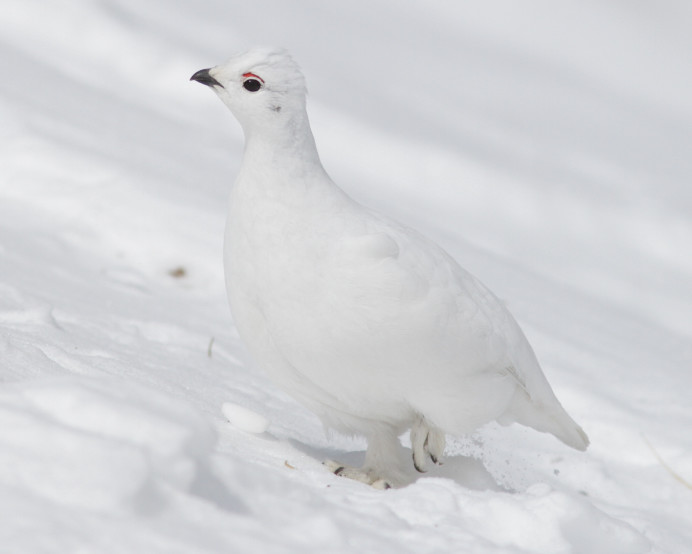
From here the journey continues to the intermountain Gunnison Basin of southwestern Colorado. This arid and cold high elevation basin supports vast stretches of sagebrush, which is one of the last remaining homes of the endangered Gunnison Grouse. With less than 5,000 birds remaining in pockets of fragmented habitat, it is one of the rarest grouse species on the planet and well worth the very early morning start necessary to see it. Outside of the town of Gunnison we have the privilege to visit a blind overlooking the only accessible lek of the species, where males perform at a distance, changing their appearance completely with a fanned tail that forms a starburst pattern and their small head seemingly disappearing within puffed up chests and inflated air sacs. A set of unruly, black plumes on the back of the head are flung forward as the air sacs deflate with a popping sound. A display that appears to require plenty of stamina. Although the grouse have moved away from the viewing blind over the years, during recent visits some birds have ventured closer, returning to their old stomping ground, pun intended. Their field marks can be easily seen through a scope with the Gunnison Grouse sporting longer plumes, lighter colored tail feathers, and is overall smaller than the more widespread Greater Sage Grouse. The morning in the Gunnison Basin is one of the most memorable of the tour as we enter the blind when it is pitch black outside, enduring a lengthy and sometimes cold wait, without any sound except for the small creek flowing through the valley. We never quite know what will stroll through the field of view or how many Gunnison Grouse will be present. The cold is quickly forgotten though among the rising excitement as we train the scopes on distant shapes moving along the ridge as the morning light frames the grouse.
Along the rim of the dramatic Black Canyon of the Gunnison, we explore patches of scrub oak and pine for the Dusky Grouse. This species does not form leks, but males perform a deep booming call while displaying reddish bare skin patches on the side of their necks and fan an impressive tail. The birds move slowly through the undergrowth and can be easily overlooked, but the muffled booming sounds followed by a loud flutter as the male performs a short, circular flight often leads birders in the right direction. Once found, these grouse are very approachable and can even perch on picnic tables. Some territorial males become particularly feisty and have been known to chase after groups of birders, offering excellent close views! The Dusky Grouse and similar Sooty Grouse were once considered to be the same species, named Blue Grouse. The Blue Grouse was split due to differences in tail shape and pattern, the color of the air sacs (bright yellow in Sooty Grouse), and slightly different calls. Wandering along the edge of the canyon, we keep our eyes on the scrubby oak woodland, looking for the slightest movement of the surprisingly large Dusky Grouse. We also enjoy the dramatic vistas of the Black Gorge of the Gunnison with its dark cliffs of gneiss and schist interspersed with colorful bands of lighter-colored pegmatite. Some of the canyon’s walls rise to nearly 700 meters (2,250 feet). From some vantage points the river is visible as a silver sliver far below and the tiny shape of a Prairie Falcon flying past offers scale to the scene. The walls of the gorge are so tall and sheer that certain parts of the canyon receive less than an hour of sunlight per day. This national park marks not only a birding highlight of the tour, but also a scenic one.
Outside the city of Grand Junction in northwest Colorado rise equally impressive cliffs, the red sandstone escarpment of the Colorado National Monument. Since there are no lekking grouse here, we can enjoy a slightly later start, but that does not mean we have run out of “chickens”. We visit a small suburb of scattered houses on the edge of the national monument and this plush neighborhood is frequented by the fancy and well-adorned Gambel’s Quail.
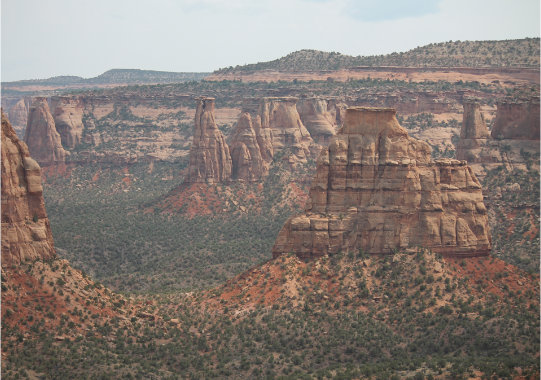
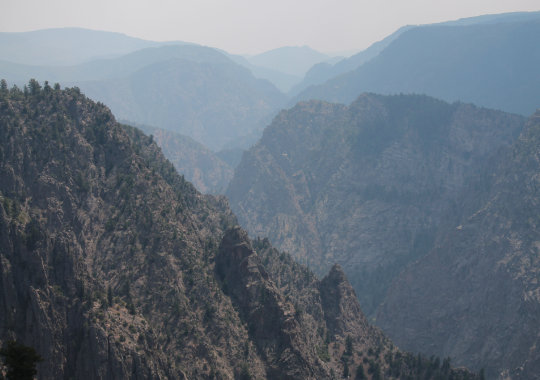
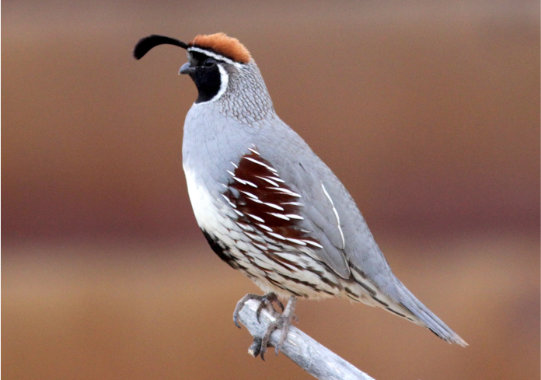
While the comma-shaped topknot forming a crest may be the most distinctive feature at first, these quail sport an intricately patterned plumage of greys, black, cinnamon, and buff. The black face is framed by white and a pale line separates the cinnamon crown which grades into fine vermiculations of grey on the back of the neck. The remainder of the upperparts and breast are grey and offset by a blackish belly surrounded by buff. Solid patches of rufous on the side of the breast and flanks continue as braided streaks to the buff undertail. To add to it all, white flecks and streaks running across the rufous flanks look as if an impressionist painter had a few brush strokes atop a canvas of realism. Fortunately, it is often possible to admire this fine bird from close quarters as males will readily call from the top of bushes or fences.
We continue north to be in position the following morning to search for Sharp-tailed Grouse. It is another memorable morning as we watch these birds stomp their feet and spin in circles with blue air sacs inflated. The performance is distinctive as the birds spread out their wings and cock their tails that narrows to a point. In addition, the birds raise yellow combs above their eyes and make cooing calls as their feet patter at a dizzying pace. Occasionally, a territorial Dusky Grouse is also present, chasing the Sharp-tailed’s around. The displaying Sharp-tailed Grouse are so preoccupied chasing each other and to outclass other dancers that we can often get very close.
The final lek of the tour is a highlight and we drive predawn into the open sagebrush steppe outside the forlorn town of Walden, which sits in the middle of Colorado’s least populated county. The vehicle tires crunch through a layer of fresh snow as we drive onto the open plain surrounded by low mountains. The massive shapes of Sage Grouse are easily visible even in weak moonlight as they strut across the blanket of fresh snow. Rolling down the windows and opening the doors of the vehicles does not only allow freezing air to rush in, but we can also hear the liquid popping sounds of the male’s booming. Soon, the snow atop the distant mountain peaks reflects red hues and minutes later the beaming sun streaming across the open fields renders these beautiful grouse in fine detail. The white breast feathers are fluffed up and frame the yellowish air sacs that inflate as the males gulp in air, giving echoing popping noise upon release. During this choreographed performance, an individual Sage Grouse fans its spiky tail, raises yellowish combs above the eyes, and flaps wings mottled in greys and browns. This display continues for hours as females gather to inspect the males that constantly defend territories only a few meters across. Observers are close enough to feel the deep booming and hear their feet stomping on the fresh snow. The lek outside of Walden is impressively large with up to 100 birds present at once. This is one of the finest spectacles of the tour and one of the most dramatic natural history events in North America.
